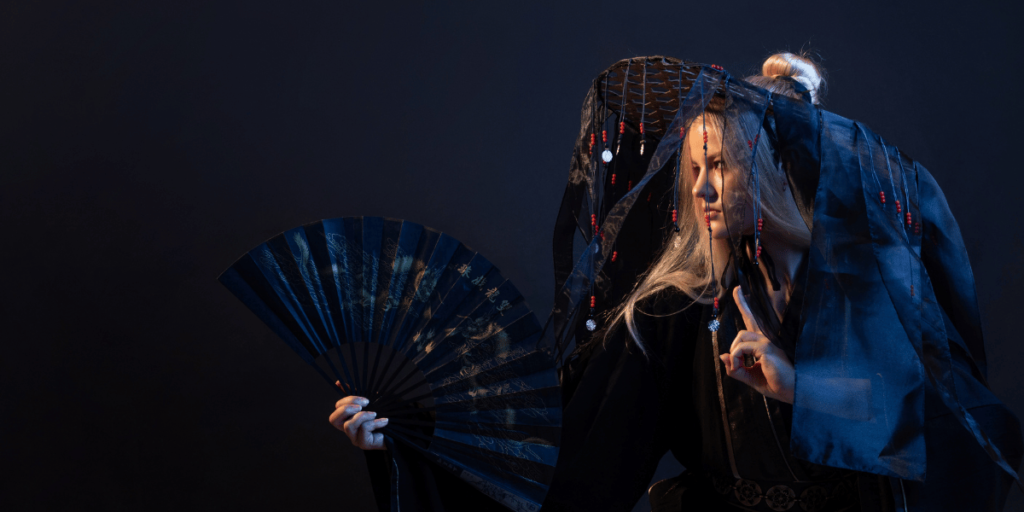Unpacking the Haori: An In-Depth Analysis of the Japanese Outwear It is a realm of fashion where traditional elements add a certain flavor to its participating elements, and the age-old art of weaving comes alive in fabric manipulation. In Japan, the haori is not just a stylish jacket that has been worn by generations but rather history of the people who are in that geography, a structure from cloth. However, there has been notable change in the design of this garment from the history of the samurai. This work seeks to unpack its culture elaborately, its meanings while serving as an effective tool for the vituative of describing the Japanese heritage for both enthusiasts and non-enthusiasts alike because the haori has become the Japanese American community ethnic costume.
Introduction to the Haori Jacket: What is it and where it came from?
Notably, the impact of haori jacket is not limited only to the clothing, but is a perfect representation of the culture and belief of the people. The haori, it appears, has extended from the fabric of indigenous clothing of Japan to the reigning fashion trends of the world. This survey is for those who find beautiful form or splendid heroic patterns more than interest in what adornment haori belongs to, for this understanding expands both General Haori and the contours of its perception.
Think about the experience of putting on a haori and feeling the connection to hundreds of years of history anytime one wishes to wear the modern fashion item. This practical jacket can upgrade any look, be it for a casual stroll or an important meeting. We invite you to take on the journey into the haori jacket—talking about its history, forms, and ways of customization.
The History of the Haori: How this traditional garment evolved over time.
If there is a single piece of clothing in Japan that one can call traditional, it is the haori jacket which has historical roots back to the Edo period(1603-1868). Initially, it was mainly a functional over garment worn over yukata or kimono. Its original function was quite clear; warmth and protection from the weather.
However, the haori also changed with the change of the systems in Japan. By that time, which is in Meiji era (1868-1912), the haori was no longer just a used clothing. It became a medium of expression and class differentiation.
During this period, art blossomed. The weavers explored the limits of fabric, pattern, and color. This is when the haori with richly detailed designs and art began to narrate a history or convey a culture began to come to be.
However, in the post war Japan, this accessory became popular worldwide as well. Its beauty was embraced by the designer community that created modern versions of it although still maintaining the core of the piece. The haori still remains a part of Japanese culture whose inspiration is vivid in contemporary fashion.
The Japanese Koshu Peddler Dress and Its Characteristics: Embroideries in Action wear and looks
The versatility of haori jackets extends to style diversity that indicates different cultural traits or aesthetics.
The most popular type is the standard kimono haori long and straight cut and its usual length is mid thigh. This type is unisex, and this is flexible.
And next the followers wear the uchikake which is typically the outer layer worn over another inner clothing that is formally used for official occasions. They are often heavily embroidered appear to cover the whole garment quite nicely.
Meanwhile, the modern one which is also for more formal appearances are described as urban or contemporary haoris. Such versions may bring unexpected color dip intech or denim fabric rather than what is norm.
Note similarly that there are also winter variants that will be that winter haori made with some lighter materials so as to leave the wearer fresh in the exception. Tango vests also come with an ancestral and artistic touch that can bimprove various outfits.
The Art of the Modern Haori: What is useful in terms of accessorizing and styling a haori jacket
Imagine wearing a simple haori on a casual day and instantly upgrading your overall style. You can start with cortes which is an excellent option for pairing a haori. One of the silk and cotton haori exudes formality while the other is casual.
Haori requires complete dressing. Always wear it over a slim styled shirt or a turtleneck to make it pop. Alternatively, a plain t-shirt does the trick well if relaxed is the intent.
Also, adding accessories will do good for your wardrobe treatment. A waist belt can be styled on top of the garment to enhance the silhouette, yet remain comfortable.
Jewelry should be subtle, yet culturally inspired as such wooden necklaces or cultural symbols worn as pendants, for example. Shoes can be any footwear from chic loafers to ethnic sandals, depending on an event.
Of course, having fun involves startling things. Do this with questions such as color combinations and textures until self-discovery is made coupled with admiring this amazing work of Japan’s heritage.
The Meaning Behind the Designs: Symbolism and significance of patterns on haori jackets
There is no lack of stories with respect to the patterns on haori jackets. Such designs have deep roots in the history of the people and often depict their surroundings or even virtual stories.
For instance, crane symbolizes good health and long life. This is a famous motif among those who wish to attract favorable circumstances in their lives. A wave is another slide pattern, where the waves symbolize strength and flexibility.
Also, common are floral designs. Cherry blossoms display the attractiveness of the passing moments, and chrysanthemums reflect excellence and aristocracy.
Colors play a crucial role too. Plain and darker colors indicate dignity and sober chic fashion for example while the light color is more of smart casual.
These detailed patterns dress the haori clothed illusion in good cosmetics that hold meaning in successive periods. The speaking jacket indeed becomes the contemporary signature of the people’s background.
Where to Buy a Haori: How to track down real haori jackets either in Japan or over the internet
Getting a genuine haori can be a fun experience. In Japan, the first reliable places to visit would be traditional markets and shops in the cities of Kyoto and Tokyo. These range from shops that deal in kimono culture and therefore, these shops usually have the best class of haoris.
Still, many online stores dealing with Japanese dresses are available for those who do not have a chance to visit Japan geographically. Some platforms like Etsy have craftsmen selling designs that are hard to come by while other extensive platforms offer everything from vintage dresses to modern day clothes.
When buying clothing online, pay particular attention to the material and the artistry. Authentic haoris generally carry great art and from the best materials too. You should always check the reviews or ratings of an item before you purchase to make sure it is the real deal.
Nothing beats social media. Bennett assures her followers who are fans of Japanese fashion, whom they often indicate through influencers; people will discover rare haori jackets that could very well be the missing addition to their wardrobe.
‘New proportions’ of the Jacket: Fashion houses interpret the definition of the original jacket
Japanese-style coats have evolved and grown more and more in the modern fashion world. Different designers nowadays are gaining inspiration from historical pieces but collide into the present fashionable people’s outfits.
The loose streets style of haori that incorporates layering has been adopted by the street wear brands. Due to this reason, they can be worn on top of jeans or even on joggers for a smart casual look. The bright colors and the bold designs are trendy but still achieve the purposes of this heritage clothing.
Eco-friendly fabrics are also becoming more common in this clothing particular wear. Many creators emphasize on the eco-conscious aspect of their production and sell haori jackets that are made from organic or recycled materials. In other words, this type of clothing honors the past while fitting into contemporary society.
Fashionistas also display their personal style in wearing haori that is, layered over a turtleneck top or worn over an oversized tee for an apparent chic look. The haori is geared for all purposes including informal activities and events, thus making it appealing to a larger population.
Maintenance and Care: Tips for preserving and caring for your haori jacket
Caring for your haori jacket is vital if it is to remain a beloved piece of clothing for many years. Begin by assessing the type of fabric, since fabric types determine the mode of washing.
Halim and cotton made haoris are best washed in cold water, by gentle hand wash.Here mild soap can be used and it is not allowed to be rubbed so tightly.The statement holds true especially for haori silk jackets of which many people steam as opposed to cleaning using solvent.
In every instance either living in haori or owning a haori, a cool and dry place is imperative.Even while it is evoqued that dress is hung on padded hangers to retain the shape and no creases are produced on it, sun protective measures have to be implemented to forestall negative photodegradation.
Should you discover that the material is creased, do not use an iron on it; just use steam spoilers, steam is safe and eliminates the folds without causing devastation to the fibers of the fabric that are there on the mantle.
To conclude, it should be normal to pans with other clothing’s in a closet. This way, it not only extends the useful life of the garment but also allows an owner to appreciate the enclothesment of the type of interest they have.
Conclusion: Why the haori
The haori jacket is much more than clothing, but it is also a cultural element of the Japanese people. Its history throughout the years is art, practicality and fusion is what makes it unique in the fashion space.The haori is commonly revered both for its past character and for its contemporary headway and as such when draped on one feels as if they are draped in class of all the ages.
In terms of aesthetics, this is a piece of clothing that will go exceptionally well with any sort of attire, both in formal and casual settings. The myriad of materials and fabrics means there is something for everyone, from the most intense bright hues to the most fluent natural colors. Embroidery on each garment has a tale to tell revealing the skill and creativity that goes into this wonderful attire.
As the global audience becomes more interested in the world of sustainable fashion, the haori is one of those garments that lift the contemporary spirit while exuding an off-timeliness. It gives way to the unique expression of our identity but with consideration to the cultural perspective.
Integrating the haori into your clothing is not merely about being fashionable, it is about embracing the character of a people whose clothing is very symbolic and customized. This unique coat not only makes the wearer happy due to their fine appearance but also presents a special invitation to comprehend the stories behind each seam.
It is easy to adopt the haori, be it for age- old authentic vintage pieces or the new haori constructed by contemporary designers, and still look good – one beauty of Japan’s style which will surely transcend through fashion trends.






